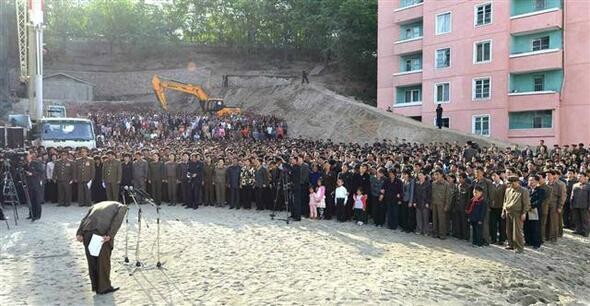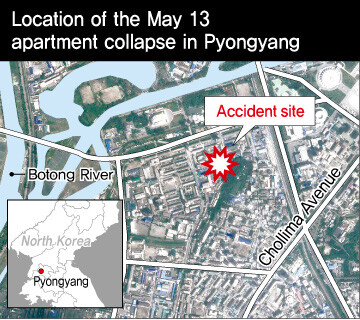hankyoreh
Links to other country sites 다른 나라 사이트 링크
N. Korea apologizes for building collapse

By Choi Hyun-june, staff reporter
A 23-story apartment under construction in central Pyongyang collapsed on May 13. Five days later on May 18, North Korean authorities announced the disaster through the country’s official media, as well as a surprise apology by officials responsible for the project.
North Korea has reported on natural disasters such as flooding in the past, but it is highly unusual for it to share news with the outside world about manmade disasters, which are seen as “shameful.” The South Korean government estimates that many who took up residence in the building before its completion may have been injured or killed.

■ Scale and Cause of the Disaster
North Korea’s state-run Korean Central News Agency reported on the disaster on May 18.
“A human tragedy occurred on May 13 with a terrible accident at a construction site in the Pyongchon district of Pyongyang, the result of irresponsible behavior by workers who haphazardly constructed a residential building and failed to conduct proper oversight and control,” the report said.
The agency added that a national emergency team had immediately been assembled to rescue survivors and treat the injuries, and was waging a “tense battle” to clean up the scene of the collapse.
While North Korea did not announce the number of deaths or injuries, the fact that an “emergency team” was organized suggests a fairly large-scale disaster.
“On the afternoon of May 13, a 23-story apartment in the Ansan No. 1 neighborhood of Pyongyang’s Pyongchon District collapsed, apparently taking quite a few lives,” said a South Korean government official on condition of anonymity.
“The construction hadn’t been completed, but there were reportedly 92 families living there, so the death or injury toll is believed to be high,” the source added.
For statistical purposes, North Korea’s definition of “household” is a five-person family, which means in numerical terms that as many as 460 people may have been killed or injured in the collapse.
But the source added, “The collapse happened on a weekday afternoon, so it doesn’t appear there would have been many people at home.” Also, the scale of deaths or injuries can vary substantially depending on the type of collapse.
Some speculation is already surfacing on the cause of the collapse. Referring to the disaster, KCNA said, “severe accidents like the one today have been caused by shoddy construction methods” and referred to a “failure to properly control a residential construction project.” From this, it appears that the cause may have been poor construction methods and lax oversight on site.
But perhaps the most likely cause lies with North Korea’s characteristic “speed campaign” approach, which routinely puts immediate results ahead of safety. At the opening of the Masik Pass Ski Resort early this year, Pyongyang emphasized the “Chosun [Korean] speed” of the project, noting that the construction was completed in just one year. Previous slogans have included “Chollima speed” and “Huichon speed.”
Pyongchon, the district where the collapse occurred, is located southwest of central Pyongyang and is home to the Chollima and Saemaul avenues, the Pyongyang Thermal Power Station, and many education institutions. It occupies a fairly important position within the city just to the west of the city’s Central District, home to many key administration sites like Mansudae Assembly Hall and Kim Il-sung Square. It is reportedly home to mainly middle-class families, including senior party officials and foreign currency earners.
■ Why the Unexpected Announcement?
The unusually detailed and swift announcement by North Korea, which rarely discloses internal incidents or accidents, suggests that it is taking the collapse very seriously. The concern may have been that with information less tightly controlled than in the past, news of a cover-up of an accident in Pyongyang - home to the country‘s elite - could turn public sentiments even more sour.
This may account for the detailed apologies from five officials that were provided with the collapse announcement. According to the KCNA report, officials with the Korean People’s Internal Security Forces (a national guard-like institution in the Ministry of People’s Security) who reportedly supervised the residential construction apologized for the accident as their “own responsibility,” as did the chair of the Pyongyang people’s committee and secretary of the Pyongchon district party committee.
In particular, Minister of People’s Security Choi Pu-il was quoted as saying responsibility for the collapse lay with “myself for failing to honor the Workers‘ Party of Korea’s politics of love for the people.”
“There is no way I can compensate or be forgiven for this crime I have committed before the people,” Choi was also reported as saying.
Also drawing attention was a photograph showing the officials gathered by the scene of the collapse on May 14 for a public apology to Pyongchon residents, which some observers saw as signaling a desperate attempt to quickly tend to popular discontent.
Please direct questions or comments to [english@hani.co.kr]

Editorial・opinion
![[Column] Park Geun-hye déjà vu in Yoon Suk-yeol [Column] Park Geun-hye déjà vu in Yoon Suk-yeol](https://flexible.img.hani.co.kr/flexible/normal/500/300/imgdb/original/2024/0424/651713945113788.jpg) [Column] Park Geun-hye déjà vu in Yoon Suk-yeol
[Column] Park Geun-hye déjà vu in Yoon Suk-yeol![[Editorial] New weight of N. Korea’s nuclear threats makes dialogue all the more urgent [Editorial] New weight of N. Korea’s nuclear threats makes dialogue all the more urgent](https://flexible.img.hani.co.kr/flexible/normal/500/300/imgdb/original/2024/0424/7317139454662664.jpg) [Editorial] New weight of N. Korea’s nuclear threats makes dialogue all the more urgent
[Editorial] New weight of N. Korea’s nuclear threats makes dialogue all the more urgent- [Guest essay] The real reason Korea’s new right wants to dub Rhee a founding father
- [Column] ‘Choson’: Is it time we start referring to N. Korea in its own terms?
- [Editorial] Japan’s rewriting of history with Korea has gone too far
- [Column] The president’s questionable capacity for dialogue
- [Column] Are chaebol firms just pizza pies for families to divvy up as they please?
- [Column] Has Korea, too, crossed the Rubicon on China?
- [Correspondent’s column] In Japan’s alliance with US, echoes of its past alliances with UK
- [Editorial] Does Yoon think the Korean public is wrong?
Most viewed articles
- 1[Column] Park Geun-hye déjà vu in Yoon Suk-yeol
- 2Thursday to mark start of resignations by senior doctors amid standoff with government
- 3Kim Jong-un expressed ‘satisfaction’ with nuclear counterstrike drill directed at South
- 4[Column] ‘Choson’: Is it time we start referring to N. Korea in its own terms?
- 5N. Korean hackers breached 10 defense contractors in South for months, police say
- 6Will NewJeans end up collateral damage in internal feud at K-pop juggernaut Hybe?
- 7Why Korea shouldn’t welcome Japan’s newly beefed up defense cooperation with US
- 8[Editorial] New weight of N. Korea’s nuclear threats makes dialogue all the more urgent
- 9[Guest essay] The real reason Korea’s new right wants to dub Rhee a founding father
- 10[Column] Yoon’s first 100 days should open our eyes to pitfalls of presidential system